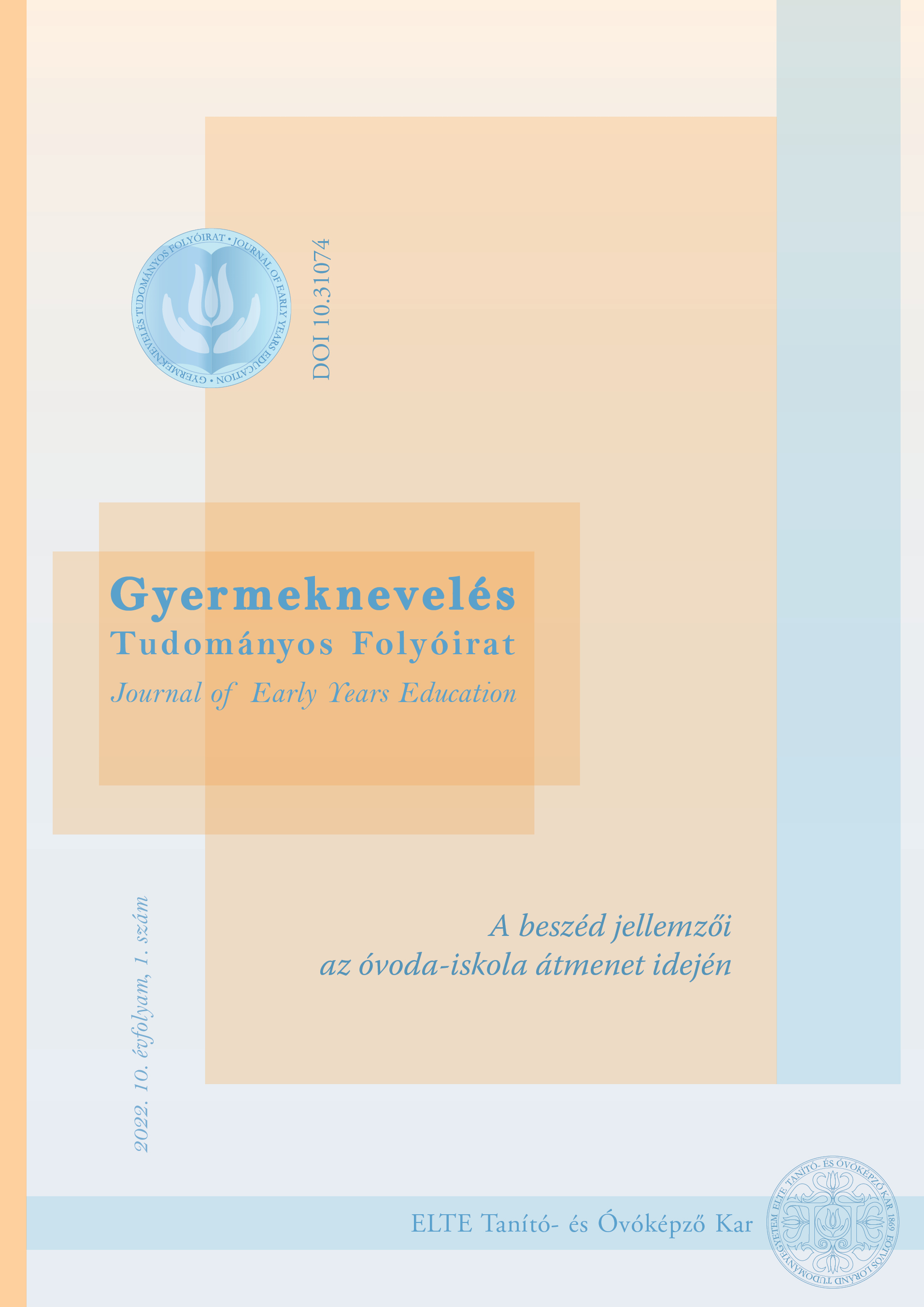Development of narrative skills of children
DOI:
https://doi.org/10.31074/gyntf.2022.1.133.145Keywords:
language acquisition, speech production, narrative skills, storytellingAbstract
Children’s narrative skills are important indicator of cognitive and language development. The narrative skills form a bridge between oral and written language. The development of children’s storytelling skills can be described by milestones and developmental stages associated with different ages. The most visible changes in these skills are related to the preschool age. The goal of this paper is to use Hungarian and international examples and experimental results to show the developmental pathway children follow from the heap stories to the creation of complex, true narratives. It also presents international methodologies for understanding and analysing narrative skills and recent Hungarian adaptations. Narrative competence is one of the key competences that the international literature has identified as having an impact on later school performance and on the acquisition of written language. The understanding of narrative competence and the Hungarian adaptation of the research methods can contribute to the objective measurement of this area of language development.
Downloads
References
Applebee, A. N. (1978). The child’s concept of story: Ages two to seventeen. University of Chicago Press.
Curenton, S. M. & Justice, L. M. (2004). African American and Caucasian Preschoolers’ Use of Decontextualized Language: Literate Language Features in Oral Narratives. Language, Speech, and Hearing Services in Schools, 35(3), 240–253. https://doi.org/10.1044/0161-1461(2004/023)
Csákberényiné Tóth, K. & Hajdú, T. (2011). Az iskolába lépő gyerekek szóbeli szövegalkotásának jellemzői. Anyanyelv-pedagógia 3. https://www.anyanyelv-pedagogia.hu/cikkek.php?id=332
Fekonja-Peklaj, U., Marjanovič-Umek, L. & Kranjc, S. (2010). Children’s storytelling: The effect of preschool and family environment. European Early Childhood Education Research Journal, 18(1), 55–73. https://doi.org/10.1080/13502930903520058
Feldman, C., Bruner, J., Kalmar, D. & Renderer, B. (1993). Plot, Plight, and Dramatism: Interpretation at Three Ages. Human Development, 36(6), 327–342. https://doi.org/10.1159/000278220
Gósy, M. (1984). Hangtani és szótani vizsgálatok hároméves gyermekek nyelvében. Akadémiai Kiadó.
Hedberg, N. L. & Westby, C. E. (1993). Analyzing storytelling skills: Theory to practice. Communication Skill Builders.
Jordanidisz, Á., Mihály, O. & Bóna, J. (2021). A dinamikus mérés lehetőségei óvodások narratív készségeinek értékelésében. Alkalmazott Nyelvtudomány, 21(1), 1587-1061. https://doi.org/10.18460/ANY.2021.1.007
Justice, L. M., Bowles, R., Pence, K. & Gosse, C. (2010). A scalable tool for assessing children’s language abilities within a narrative context: The NAP (Narrative Assessment Protocol). Early Childhood Research Quarterly, 25(2), 218–234. https://doi.org/10.1016/j.ecresq.2009.11.002
Laczkó, M. (2011) Óvodások és kisiskolások spontán mondatalkotási folyamatai. Magyar Nyelvőr 135(4), 440–459.
Lengyel, Zs.(1996). Nyelvelsajátítási és nyelvtanulási formák.Veszprémi Egyetemi Kiadó.
Mandler, J. M. & Johnson, N. S. (1977). Remembrance of things parsed: Story structure and recall. Cognitive Psychology, 9(1), 111–151. https://doi.org/10.1016/0010-0285(77)90006-8
McFarland, L. (1992). A study of the narrative skills in kindergarten children with normal, impaired, and late developing language development. https://doi.org/10.15760/etd.6294
Merritt, D. D. & Liles, B. Z. (1987). Story Grammar Ability in Children with and without Language Disorder: Story Generation, Story Retelling, and Story Comprehension. Journal of Speech, Language, and Hearing Research, 30(4), 539–552. https://doi.org/10.1044/jshr.3004.539
Murányi, S. (2018). A szavaktól a történetekig. Anyanyelv-pedagógia, 11(3), https://doi.org/10.21030/anyp.2018.3.2
Murányi, S. (2019). A gyermekkori narratív készségek vizsgálata – Az ENNI módszertanának alkalmazása magyar nyelven. Alkalmazott Nyelvtudomány 19(2), http://alkalmazottnyelvtudomany.hu/wordpress/wp-content/uploads/Muranyi_tan.pdf
Murányi, S.(2020). A narratív készség fejlődése óvodáskorban. In Bóna, J. & , Krepsz, V. (Eds.), Nyelvfejlődés csecsemőkortól kamaszkorig (pp. 175–194). ELTE Eötvös Kiadó.
Rumelhart, D.E. (1975). Notes on a schema for stories. Representation and understanding: Studies in cognitive science (pp. 185–210). Academic Press.
Schneider, P., Hayward, D. & Dubé, R. V. (2006). Storytelling from pictures using the Edmonton Narrative Norms Instrument. Journal of Speech-Language Pathology and Audiology, 30. 224–238.
Schneider, P. (1996). Effects of Pictures Versus Orally Presented Stories on Story Retellings by Children With Language Impairment. American Journal of Speech-Language Pathology, 5(1), 86–96. https://doi.org/10.1044/1058-0360.0501.86
Schneider, P., Dubé, R. V. & Hayward, D.(2005) The Edmonton Narrative Norms Instrument. University of Alberta Faculty of Rehabilitation Medicine.: www.rehabresearch.ualberta.ca/enni.
Schnell, Zs. (2016). Az elme nyelve - Társalgás és nyelvfejlődés. Akadémiai Kiadó.
Stadler, M. A. & Ward, G. C. (2006). Supporting the Narrative Development of Young Children. Early Childhood Education Journal, 33(2), 73–80. https://doi.org/10.1007/s10643-005-0024-4
Stein, N. L. & Glenn, C.(1975). An analysis of story comprehension in elementary school children. Newdirections in discourse processing. Ablex. 53–120. https://files.eric.ed.gov/fulltext/ED121474.pdf
Thorndyke, P. W. (1977), Cognitive structures in comprehension and memory of narrative discourse. Cognitive Psychology, 9(1), 77–110. https://doi.org/10.1016/0010-0285(77)90005-6
Westby, C. (2012). Linguistic Coding of Theory of Mind. Word of Mouth, 23(4), 12–14. https://doi.org/10.1177/1048395011434078d
Downloads
Published
How to Cite
Issue
Section
License
Copyright (c) 2022 Author

This work is licensed under a Creative Commons Attribution-NonCommercial-ShareAlike 4.0 International License.

